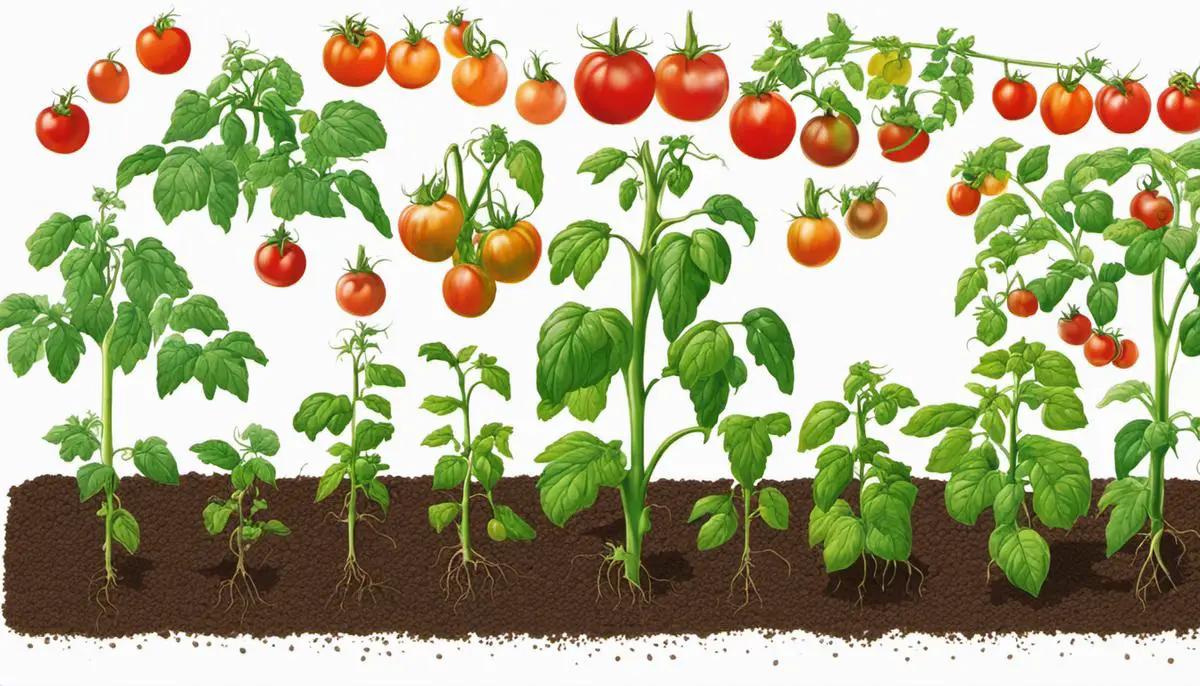Table of Contents
Organic farming is an eco-friendly agricultural solution that prioritizes the health of people and the planet. It thrives on principles that align with nature, encompassing natural pest control, soil enrichment, and plant nourishment techniques. Understanding the nuances between organic and traditional farming practices is key to recognizing the benefits of this sustainable initiative. Organic tomato farming, in particular, underscores these principles.
In this endeavor, one must be fully tuned into the unique requirements of tomato plants from essential conditions like sunlight, temperature, water needs to their life cycle intricacies. Unearthing facts about when to seed, how best to take care of the young plants and master timing for reaping the harvest are all part of this process. Left untouched, tomatoes have the potential to succumb to pest attacks or diseases, making it important to address these drawbacks in an organic manner.
Understanding Organic Farming
Understanding Organic Farming Principles
Organic farming is centered around the idea of cultivating food in a way that is respectful of nature. This means farmers avoid using synthetic pesticides and fertilizers, and instead turn to natural methods. When it comes to pest control, organic farmers often work with nature, introducing predators of the pest insects or using plant species that naturally deter pests. Furthermore, the reliance on synthetic fertilizers is displaced by compost, manure and green manure, which also helps in improving soil health.
Soil Enrichment in Organic Farming
Soil enrichment is a key principle in organic farming. Instead of using synthetic fertilizers, organic farmers enrich the soil with organic matter to introduce nutrients. Compost, made from vegetable waste, grass clippings and other biodegradable materials, provides nutrients and also improves the soil structure, increasing its capacity to retain water. The use of green manure – plants that are grown and then plowed back into the earth – also helps to provide nutrients and organic matter to the soil.
Natural Plant Nourishment
In organic farming, the nourishment of plants relies heavily on the condition of the soil. The better the soil, the more nourished the plants will be. Organic farmers often make their own homemade fertilizers using kitchen and garden waste. In addition, crop rotation is practiced where different types of crops are grown in sequential seasons to prevent nutrient depletion in the soil.
Organic Versus Conventional Farming
There are key differences between organic and conventional farming. Conventional farming often utilizes synthetic pesticides and fertilizers to control pests and enrich the soil. Organic farming, on the other hand, uses naturally derived pesticides and fertilizers. Additionally, conventional farming may use genetically modified organisms (GMOs), whereas organic farming prohibits the use of GMOs. These differences result in a clear divide in farming methods, with organic farming prioritizing environmental sustainability over high yields.
The Benefits of Organic Farming
Organic farming has numerous benefits. It enhances soil health, fosters a diversity of insects and plants, and promotes a healthier ecosystem overall. Additionally, it can produce foods that are free of certain chemicals and are rich in certain nutrients when compared with conventionally grown foods. The practice also has wider environmental benefits, including reduced pollution from fertilizers and pesticides, and increased biodiversity. Overall, understanding how organic farming works – from natural pest control to soil enrichment and plant nourishment – can allow us to appreciate the value of this sustainable approach to agriculture.

Specifics of Tomato Cultivation
Understanding the Lifecycle of a Tomato Plant
A tomato plant, from seed to fully-grown fruit-bearing plant, goes through various stages. The journey begins with the planting of a small seed, which eventually germinates into a seedling. This is the first stage. The seed then transitions into the vegetative stage, where it begins to rapidly grow leaves and branches. The next stage is flowering, where yellow blossoms appear. This is the precursive sign of fruit development. These flowers then turn into small green tomatoes, marking the start of the fruiting stage. The final stage is the ripening phase, where fruit turns from green to red, becoming sweeter and ready for harvesting.
Ideal Conditions for Tomato Growth
Tomato plants need at least six to eight hours of sunlight daily, but the more sun they receive, the better they will taste. When it comes to temperature, they prefer relatively warm conditions. A daytime temperature range of 65-85 degrees Fahrenheit is optimal, with night-time temperatures falling between 59-68 degrees F.
As for water, tomatoes need about 1-2 inches of water every week, but this can be adjusted depending on the local climate. Underwatering can lead to a lower yield while overwatering can cause diseases. Thus, proper soil moisture is paramount.
Seeding Tomatoes
Tomato seeds should be started indoors to allow them to grow in a controlled environment. Plant the seeds about 1/8 inch deep in a good quality seed starting mix. Keep the soil consistently moist and in a warm area, between 70–80 degrees F. Once seedlings develop two sets of true leaves, they can be transplanted into larger pots before being eventually moved outdoors.
Caring for Young Tomato Plants
Once the threat of the last frost has passed, you can transplant your tomato plants outdoors. Be sure to harden off the plants first; this involves gradually acclimating them to outdoor conditions over a week. When planting, bury them deep in the soil as this will encourage roots to grow along the stem. Make sure to space the plants properly. When properly cared for, young tomato plants become strong and set the stage for a successful fruiting season.
Harvesting Tomatoes
When tomatoes reach their full diameter and attain a full, deep color, they are generally ready for harvest. This tends to be about two to three months after planting. Simply take hold of the ripe tomato, twist until the stem snaps, and pull the fruit free. Tomatoes can be stored at room temperature until usage – refrigeration is only required if they are overly ripe and need to be preserved for a later time.

Organic Soil Preparation and Fertilization
Organic Soil Preparation
Kick-starting your organic tomato farming journey begins with soil preparation. The soil is the backbone of your garden and provides nutrition to nurture your tomatoes. Start by cleaning the area thoroughly, removing weed and grass, as well as large stones or other debris. Remember, tomatoes prefer well-draining soil, so avoid areas prone to waterlogging.
Next, perform a soil test. Use a soil test kit from a gardening store or send a sample to an agricultural lab. This helps you understand the soil’s existing nutrients and pH levels. Tomatoes thrive in nearly neutral soil with a pH of 6.0 to 7.0. If the soil is too acidic (below 6.0), dolomite lime will help balance it. If it’s too alkaline (above 7.0), sulfur will bring the pH down.
Incorporating Organic Matter
To improve the soil structure and nutrient content, incorporate organic matter. This suppresses diseases, improves water retention and provides a conducive environment for beneficial soil organisms. Aged compost or well-rotted manure can be added into the soil several weeks before planting. The recommended ratio is 2-3 inches of compost or manure for every 6-8 inches of soil.
Organic Fertilizers and Amendments
Use organic fertilizers to add necessary nutrients to the soil. The three main nutrients required by tomatoes are nitrogen, phosphorus, and potassium. Nitrogen encourages healthy foliage, phosphorus supports a strong root system and fruit development, and potassium promotes vigorous growth and resistance to diseases.
You can find these nutrients in organic fertilizers such as bone meal (rich in phosphorus), cottonseed meal (high in nitrogen), and greensand (a good source of potassium). Apply these fertilizers according to package instructions or soil test recommendations.
Maintaining Soil Health
Once your tomatoes start growing, maintaining soil health is paramount. Ensure the soil remains fertile by adding side dressings of compost or manure during the growing season. Regularly pull out weeds that compete with your tomatoes for nutrients and water. Remember to rotate your crops each year to prevent the buildup of diseases and pests.
Moreover, cover cropping or green manuring can also be beneficial. Planting certain crops like clover or rye in the off season can improve soil fertility, structure, and organic matter content when they are turned into the soil.
Committed to Organic Farming
Committed to organic farming practices, all these steps not only aid in producing bountiful, high-quality tomatoes but also contribute to a healthier, sustainable environment. Remember, as in all farming endeavors, patience and continuous learning are key to success.

Organic Pest and Disease Management
Recognizing Common Pests and Diseases in Tomatoes
Organic tomato farming requires a keen eye in identifying common pests and diseases that could potentially infest your crop. Among the usual suspects are aphids, tomato hornworms, cutworms, stink bugs, whiteflies, blossom end rot, and early blight. Aphids and whiteflies are tiny insects that suck sap from tomato plants leading to stunted growth. Tomato hornworms, cutworms, and stink bugs cause damage by eating the leaves, stems, and fruits. Blossom end rot is a calcium deficiency causing blackened end in fruits, while early blight is a fungal disease causing dark spots on leaves.
Inviting Beneficial Insects in Your Garden
A well-balanced ecosystem is key to a healthy organic garden. Certain insects, such as ladybugs, lacewings, and spiders, prey on harmful pests. Attracting these beneficial insects can be done by planting flowers with nectar, like cosmos, sunflowers, and marigolds, in your garden. These insects will act as a natural pest control, reducing the need for pesticides.
Managing Pests with Organic Pesticides
When the pest infestation is too heavy, organic pesticides can be used. These are derived from natural sources and include insecticidal soap, neem oil, and diatomaceous earth. Insecticidal soap works well against soft-bodied insects like aphids and whiteflies. Neem oil disrupts the life cycle of pests, preventing them from growing into mature insects. Diatomaceous earth, on the other hand, is a powder made from fossilized aquatic organisms that kills pests by puncturing their exoskeletons. Always remember to use these products sparingly and only when necessary.
The Power of Crop Rotation
The soil health is an essential aspect of organic farming. Crop rotation is a practice where different plant species are grown in the same area in sequential seasons. Growing tomatoes in the same spot every year can lead to a buildup of diseases and pests in the soil. By rotating crops, you can interrupt the life cycle of pests and diseases, keeping them from becoming a significant issue. Similar to tomatoes, crops like peppers, eggplants, and potatoes should be avoided in rotation since they are from the same family and prone to similar pests and diseases.
Observing and Acting Proactively
Preventing pests and diseases is easier and more effective than trying to eliminate them once established. Regular inspection of your plants can help you catch problems early on, while they’re still manageable. Be on the lookout for changes in leaf color, spots, and signs of pests. By acting proactively, you can ensure a healthy, fruitful harvest for your organic tomatoes.

Learning about organic soil preparation and using organic fertilizers for improved soil health is just as important as understanding tomato farming. Organic soil is the foundational bedrock of this type of farming. Key factors such as maintaining the right soil pH level, knowing the required nutrients, and adopting measures to maintain soil health organically, play crucial roles.
In the battle against tomato pests and diseases, organic solutions like encouraging beneficial insects, practicing crop rotation, and employing organic pesticides are highly effective. Embracing the principles of organic farming and implementing them effectively will foster a healthier environment and yield produce that is free from harmful chemical residues, promoting overall well-being and sustainable growth. Learning, adopting, and encouraging organic farming is the way forward for a sustainable, healthy future.
